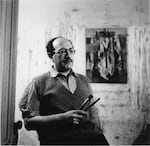On a rainy New York evening in May of 2012, Mark Rothko's painting Orange, Red, Yellow went up for auction at Christie's. As bidding began, it became clear this was no ordinary auction. Barrett White, Christie's executive deputy chairman recalls the air in the room was "electric."
According to White, a typical sale lasts about two or three minutes, “and for the Rothko, the bidding war lasted for seven minutes, with over 50 bids made.”

Abstract master Mark Rothko.
Courtesy of the Rothko Foundation
In the end, the painting sold, with commissions, for over $86 million, breaking all existing records for a contemporary work of art. “Not only was the sale the world record for the artist at the time,” White recalls, “it was the most expensive post-war and contemporary art work ever sold. In the world.”
What is it about a Rothko that inspires so much awe and attention? How do these seemingly simple paintings contain so much power?

"Rothko: Pictures Must Be Miraculous"
Watch the full PBS American Masters documentary film.
And, simple? Maybe not.
Carol Mancusi-Ungaro, the associate director of conservation at the Whitney Museum of American Art in New York, spent seven years restoring the murals at the Rothko Chapel in Houston. “I think Rothko’s one of our great American artists,” she says. “He started a new way of thinking about painting and creating paintings.”
“There’s nothing simple about Rothko’s work,” Mancusi-Ungaro says. “It’s actually very complex. If you think it is simple you should try to do it yourself.”
Painter Mako Fujimura agrees. “Mark Rothko’s work opens you up in ways you’re not expecting. I've known two people who have sat in front of Rothko for an hour, and it has literally changed their life.”
And all this from a guy who graduated from Lincoln High School, right here in Portland, Oregon.
Mark Rothko was born Marcus Rothkowitz in 1903 in Dvinsk, then part of Russia. The town was part of the Pale of Settlement, a swath of land where Jews were allowed to live. Rothko’s father faced the grim prospect of being drafted into the Russian army, so the family immigrated to Portland, Oregon, already home to dozens of Rothkowitz relatives.
Young Marcus sold newspapers on Portland street corners, worked in his uncle’s downtown Portland clothing store, and eventually enrolled at Lincoln High School, where he excelled. Though Rothko left Portland in 1921 to attend Yale, he returned frequently to visit family. Even today Portland is home to dozens of Rothko relatives.
Rothkowitz moved to New York in 1923 (changing his name to Mark Rothko 20 years later). By the 1940s he was part of an avant-garde group of artists that included Jackson Pollock, Willem de Kooning and Clyfford Still. His rebellious circle was intent on making art with meaning and challenging the existing artistic scene in New York. They abandoned all attempts at painting human figures or landscapes, diving fully into the abstract.
Rothko’s group protested at museums that refused to show their work and wrote strident letters to The New York Times, proclaiming that “art is an adventure into an unknown world, which can be explored only by those willing to take the risks.” They believed that, “if our work embodies these beliefs it must insult anyone who is spiritually attuned to interior decoration; pictures for the home; pictures for over the mantel… etc.”
Their artistic movement eventually became known as Abstract Expressionism, and it dramatically changed the world of art.
Harry Cooper, head of modern art at the National Gallery of Art in Washington, D.C., says, "before this time American painters, they traveled to Europe, then they went home, and nobody really heard of them again… Right after World War II all of that changes. These painters are the talk of the world and in some sense the center of the art world shifts from Europe, from Paris, in particularly, to the U.S. and to New York. …. It's a huge moment that we're still dealing with today."
Any painter who approaches a canvas with a brush today, “they’re still dealing with… Rothko, with that level of ambition, that level of achievement,” Cooper says. “Even if they’ve rejected it, they’re trying to equal it in some way.”
Mark Rothko never lived to see his paintings sell for millions of dollars – he died in 1970. But by the 1950s he did finally begin to catch the eye of museums and galleries, and in some sense, he saw his impact on the world. “I'm interested only in expressing basic human emotions—tragedy, ecstasy, doom and so on,” Rothko said in 1957. “The people who weep before my pictures are having the same religious experience I had when I painted them.”
And here in Portland, Rothko's legacy lives on. The Portland Art Museum is now working on an ambitious plan for the new Rothko Pavilion, a 30,000 square foot addition that that will include major works by Mark Rothko, on loan from the Rothko family. Our Lincoln High graduate, our own hometown artistic hero, is finally coming home.
